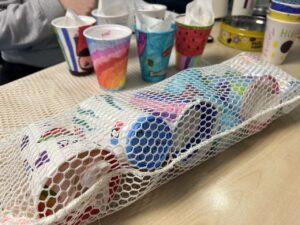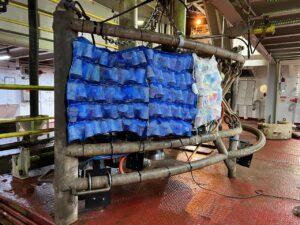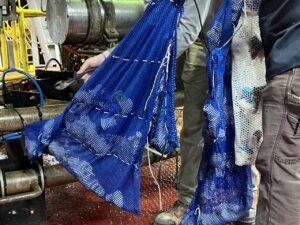
Sharing Our Science
The first time I sailed on the JR (Leg 206, 2002), there was no Internet access onboard, and email delivery was restricted to 4 downloads of text-only messages every 24 hours. I remember the dilemma of going to dinner The first time I sailed on the JR (Leg 206, 2002), there was no Internet access onboard, and email delivery was restricted to 4 downloads of text-only messages every 24 hours. I remember the dilemma of going to dinner or waiting for the email delivery to see if there was a message from home – and the inevitable disappointment if there was ‘no mail’, having waited 6 hours for it.
Since then, the addition of satellite dishes has changed the way those onboard can communicate with home. Not only can we access the Internet, we also now have enough bandwidth for Zoom calls to shore (so long as more than 2 people don’t try to call at the same time). This, combined with the general rise of video conferencing partly in response to COVID, means that onboard, our Zoom tours of the ship for the public have flourished—and I have been pleasantly surprised to discover how rewarding they are.
I have always enjoyed visiting schools (usually primary-school-age children) to tell them about my work. I particularly enjoy doing hands-on experiments with them (erupting lemonade and Mento volcanoes and making Alka-Seltzer lava lamps and edible geodes) and answering all their amazing questions. (They often ask things that should be simple to answer but turn out to be incredibly insightful and challenging).
Before coming to sea for this expedition, I paid my daughter Cassie (age 10) and her class (Nutfield Church Primary Year 5) a visit. On previous visits to her class, we’ve talked about plate tectonics, explored how the JR works, and even tried to re-enter our own seafloor re-entry cones—using drill strings made of thread weighted with a paper clip and held by a child standing on a table, and re-entry cones made from cups on the classroom floor. The driller (child on the table) was blindfolded while the dynamic positioning (DP) operator gave them directions to move the string over the hole and lower the paper clip into the cup.
On my most recent visit, we talked about pressure. We learned about how deep the oceans are—and key landmarks down through their depths. (Did you know the deepest ever free-dive [on a single breath] was to an astonishing 214 m [702 feet]?). We learned that one of the biggest problems facing underwater explorers is pressure. For every 10 m travelled deeper into the ocean there is an additional 6.47 kg of pressure on each square inch of a surface. In 1960, the bathyscaphe Trieste was the first manned vehicle to descend to the bottom of the Challenger Deep, more than 10,916 meters below the ocean’s surface. Due to the great pressure at those depths, a viewport cracked during pilots Jacques Piccard and Lt Walsh’s descent… Exploring the depths is so challenging that until the 2012 Deepsea Challenge expedition, the Trieste remained the only manned vehicle to have successfully dived so deep.

Year 5 enjoyed learning about pressure and then experimenting with how to reduce the pressure a weight exerts on an object by increasing its surface area. Using a wooden board to spread the load, we were able to stand on polystyrene cups without crushing them. Before I left to board the JR, Year 5 decorated the leftover polystyrene cups with waterproof pens, and I promised to send them 5 km below the ocean so they could see what effect the pressure had on them…
Yesterday was a very exciting day—Year 5 joined Marlo (one of our amazing Onboard Outreach Officers) and me for a Zoom tour of the JR. This included an overview of the JR and what she is capable of, a walk-about tour of key places on the boat (using our iPad) that included a visit to the bow, the bridge, a view of the derrick and rig floor, and a walkthrough of our core flow from the catwalk where we receive cores, and through the labs where they are curated, processed, and analyzed. Lots of wonderful shipboard technicians and scientists shared what they were doing and why with the children. They showed them how we laser core numbers onto the plastic core liners, image and describe cores, examine rocks under microscopes, and sieve microfossils from mud. The highlight for us was, as always, the question-and-answer session at the end of the tour. We also had a special surprise waiting for the children in the cutting room.

Their cups, which had been sewn into string laundry bags and then attached to the camera system we use to find and re-enter drill holes, and sent to 5 km the bottom of the ocean and back, were all laid out waiting for them in the core splitting room. They were so excited to discover that the cups had not been crushed by the great pressure of 5 km of water. Rather, they had shrunk to a fraction of their original size when all the air was squashed out of the polystyrene.

It was a thrill to share our science with them with this joint science-art project (I can’t resist an opportunity to combine my two favourite subjects), and I’m looking forward to visiting year 5 again when I’m home—to
give them their souvenir cups that survived an epic journey to the depths of the Atlantic—and to do a new experiment trying to take ‘sediment’ APC cores from a vanilla and chocolate layer cake using drinking straws!
Video: Marlo Garnsworthy/IODP